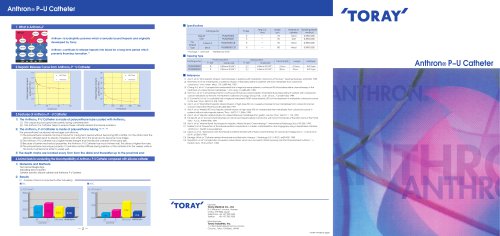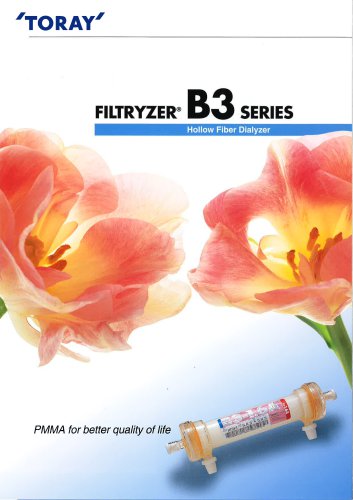 Website:
Toray
Website:
Toray
Catalog excerpts

TO RAY 1. What is Anthron®? ■ Specifications Anthron® is hydrophilic polymer which is ionically bound Heparin and originally developed by Toray. Anthron® continues to release heparin into blood for a long term period which prevents thrombus formation.11) 2.Heparin Release Curve from Anthron® P—U Catheter 3.Features of Anthron® P—U Catheter 1) The Anthron® P-U Catheter is made of polyurethane tube coated with Anthron® (1) This unique structure gives extra safety during catheterization (2) This Anthron P-U Catheter helps to reduce these catheter-related thrombosis problems 2) The Anthron® P-U Catheter is made of polyurethane tubing 12>-13)-14) The polyurethane has several advantages over silicone; (1)The polyurethane material can stay in blood for a long-term period without becoming stiff or brittle. On the other hand the silicone catheters tend to absorb cholesterol and other fat in the body and to become more fragile. (2) The Anthron® P-U Catheter has a higher tensile strength than the silicone catheter of the same size. (3) Because of better mechanical properties, the Anthron® P-U Catheter has much thinner wall. This allows a higher flow rate. (4) The polyurethane has unique property: it maintains certain stiffness during insertion of the catheter into the vessels, while in the body it will become softer to vessel wall. 3) The depth marks are located every 5cm from the distal end thereafter up to the proximal end 4.Animal tests for evaluating the biocompatibility of Anthron® P-U Catheter compared with silicone catheter 1) Materials and Methods Test Animal: Beagle dogs Indwelling term: 6 months Catheter used for: silicone catheter and Anthron®|P-U Catheter 2) Results (1 ) Analysis of blood components after indwelling ■ RBC ■WBC * Package: 1 unit/case * Sterilized by EOG ■ Referrence 1) Arai Y. et al:"Intra-hepatic infusion chemotherapy in patients with metastatic carcinoma of the liver": Gastroenterology: p318-323, 1995. 2) Kemmeny N. et al:"Intrahepatic or systemic infusion of fluirodexyuridine in patients with liver metastases from colorectal carcinoma.":Ann. Intern. Med., 107: p459-465, 1987. 3) Chang A.E. et al: "A prospective randomized trial of regional versus systemic continuous 5FU-fluorodexyuridine chemotherapy in the treatment of colorectal liver metastases.": Ann. Surg., 6: p685-693, 1989. 4) Horn D.C. et al:"A randomized trial for continuous intravenous versus hepatic intraarterial fluorodexyuridine in patient with coloreectal cancer metastatic to the liver: The Northern Calfornia Oncology Group Trail.: J.Clin. Oncol., 7: p1646-1654, 1989. 5) O'Connel M.I. et al:"A controlled trial of regional interarterial FUDR versus systemic 5FU for the treatment of metastatic colorectal cancer to the liver."Proc: ASCO, 8: 378, 1989. 6) Arai Y, et al:"Intermittent hepatic arterial infusion of high-dose 5FU on a weekly schedule for liver metastases from colorectal cancer: Cancer Chemother Pharmacol 40: p526-530, 1997. 7) Arai Y. et al:"Weekly 5FU hour hepatic arterial infusion of high dose 5FU for unresectable liver metastases from colorectal cancer in patients without extra-hepatic lesions."Proc.: ASCO 17: 285a, 1998. 8) Arai Y. et al:"Hepatic arterial infusion for uresectable liver metastases from gastric cancer."Proc: ASCO 11: 176, 1992. 9) Tanaka M. et al:"Anovel Chermotherapy for Advanced Hepatocellular Carcinoma with tumor Thrombosis of the Main Trunk of the Portal Vein": A.C.S,: P1890-1895, 1997. 10) Arai Y. et al:"Interventional Techniques for Hepatic Arterial infusion Chemotherapy": Interventional Radiology 3rd: p192-205, 1995. 11) Noishiki Y.et al:"Prevention of thrombosis-related complication in cardiac catheterization and angiograpy using a heparinized catheter, (Anthron®): ASAIO to be published. 12) Lokich JJ et al :"Subclavian vein thrombosis in patients treated with infusion chemotherapy for advanced maligunancy.": Cancer(U.S), 52(9): p1586-9,1983 13) Eskridge JM et al:"Catheter-related thrombosis and fibrinolytic therapy.": Radiology (U.S.), 149(2): p429-432, 1983. 14) Mulvihill SJ. et al:"Complication of superior versus inferior vena cava occlusion infants receiving central total parenteral nutrition.": J. Pediatr. Sura. 19(6) :p752-7, 1984. Manufacturer: Toray Industries, Inc. 1-1, Nihonbashi-Murormachi 2-chome, Chuo-ku, Tokyo 103-8666, JAPAN
Open the catalog to page 1
Anthron® P-U Catheter 1. What is Hepatic Arterial Infusion Chemotherapy (HAIC)? ■Seg-Neutrophile 1) Conventional Evaluation for HAIC 1) Hepatic arterial infusion chemotherapy has long been adopted in treating patients with liver metastases. However the efficacy of this therapy is still controversial because the randomized trial results for hepatic arterial versus systemic chemotherapy in the treatments of liver metastases from colorectal carcinoma in the late eighties did not favor for the regional hepatic arterial infusion chemotherapy for longer survival. Although the HAIC exerted highly...
Open the catalog to page 2All Toray catalogs and technical brochures
-
NF-U series
3 Pages
-
Inoue-Balloon Catheter
2 Pages
-
TR-FX
2 Pages
-
TQS-88
2 Pages
-
Filtryzer® BK-F
4 Pages
-
Filtryzer® B3
5 Pages
-
Filtryzer® BG
5 Pages
-
Filtryzer® BK
5 Pages
-
Filtryzer® B1
3 Pages











